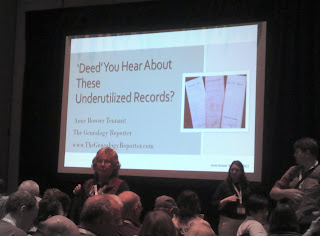That's the "write" thing to do.
Maybe you feel you're not a writer or you haven't done enough research or you need more details or photos. Please keep in mind that as the keeper of the family history, you know more than your relatives. And your relatives and heirs don't expect Shakespeare--they will be delighted just to find out who their ancestors were!
Doing the "write" thing is, in fact, an excellent way to identify gaps in research and missing leaves on the tree. If something is wrong or incomplete (incorrect spelling, inaccurate dates, missing details), you can always fix it later. Really.
Case in point: In 2012, I printed a small photo book about my parents' wedding, which united the Burk and Schwartz families. The main purpose was to reprint the many family photos with captions, for the sake of future generations. Cousins helped me identify nearly everyone in every photo. But there were some "unknowns" and I simply called them that in the captions (see above). Better done than perfect.
Fast-forward to 2017, when I smashed a brick wall and found second cousins who--wonder of wonders!--are descendants of the "unidentified cousins" in the photos. Needless to say, I immediately hand-wrote the new names into my printed photo book. Remember, the goal is to share family history with future generations, not to have an immaculate book. Earlier this year, when I saw a big sale, I reprinted the original photo book with corrections and additions.
So go ahead and do the "write" thing. Some ideas to get you in the "write" mood:
- Pick a person or a surname or an occasion, spread out your research, and jot notes you can then flesh out into sentences and paragraphs. I wrote about one set of grandparents at a time, since their lives were intertwined, but I had a separate page or two about birth/early childhood of each individual.
- Pick a photo and list the people in it. Then write a bit about each person and the relationships between some or all. Include what you know about where and when, or other details to "set the scene" for descendants who never knew these people. I found some photos so evocative that the words poured out almost faster than I could type.
- Ask your audience (children or nieces/nephews or any other readers) who or what they'd like to know about. My family asked for a booklet about Mom and her twin sister. I'm making notes already. My sis-in-law wants a book about her parents. I'm scanning photos in preparation.
You don't have to start at the beginning as you write. Sometimes the best way to get yourself going is to begin with something dramatic or humorous or characteristic of the person. My blog posts often serve as a rough draft of a family history booklet.
There's no one "write" way to write family history. You can write one page about one person, or a pamphlet about a couple, or a book about a family. You might decide to tell the stories in photos with captions, rather than using a lot of text. The important thing, as I said at the beginning, is to start writing. Enjoy the journey, and your family will enjoy what you write.










































